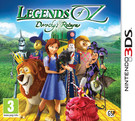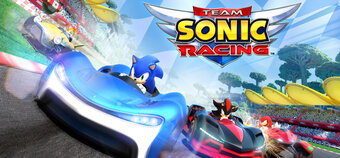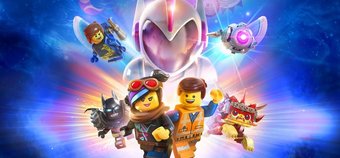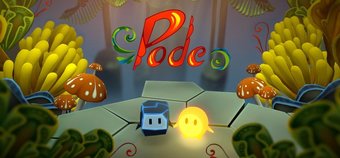With most kids' games, we know what we're getting ourselves into. In the run up to release, there's usually an absolute barrage of posters, publicity and press releases promoting the latest big family film, and the obligatory tie-in game that goes with it. Yet, we'd be surprised if more than a handful of people have actually heard of Legends of Oz: Dorothy's Return - or at least, the film it's based on. Having seemingly gone the always successful route of releasing without so much of a peep of publicity - or perhaps it was deliberately attempting to fly under the radar - the film's been universally panned by critics, and has been a massive box office flop, despite featuring an A grade celebrity cast, having cost some $100m to put together, while grossing just $9m.
But thankfully, the game's a lot better than its source material.
A match three game aimed at a young audience, Legends of Oz: Dorothy's Return loosely retells the story of the film, with a few brief (fully voiced) talking heads relaying the story as you play across a number of block swapping, match making, c-c-combo breaking levels. With bright colours, detailed backgrounds, and a surprising amount of variety, this is better than the average match three tie-in.
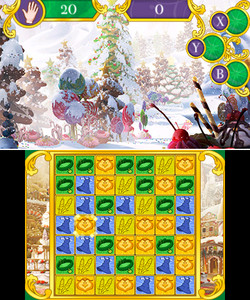
Welcome to Candy County. Population: you.
In fact, while kids games have had a pretty bad rap (and often unfairly so) in recent years, Legends of Oz is a solid match three game for both young and old alike. Taking a slower pace than reaction based games like Bejewelled Blitz, Legends of Oz strikes a balance between being forgiving, and providing a challenge for little ones to work at. For instance, while most stages set you a time limit in which you have to earn a certain amount of points, the time limit itself is as lenient as it can be - as soon as you've made your move, the timer will pause, while your cavalcade of chain reactions blow themselves up. Putting a stronger emphasis on earning combos, as not only will they earn you loads of points, but they'll do so without eating away at your timer, it's a nice little touch to encourage intelligent play.
Interestingly, especially for a kid's game, there's a surprising amount of variety in the stages here too. While most have you simply trying to reach a target score against the clock, others challenge you to be more strategic. Some ask you to reach a score in a certain number of moves, rather than a certain number of seconds - putting even more emphasis on the aforementioned combos - while others ask you to make a certain number of item matches in order to clear the stage.
The item match stages are possibly the hardest ones in the game, though, as the items you're supposed to be matching are so few and far between. Asking you to match, for example, seven pieces of broken crockery, you'll likely only have a maximum of three pieces on screen at any one time, meaning you'll have to be very careful with the matches you make. Trying to move the pieces towards each other, without accidentally burying them in the bottom corner of the grid under a cavalcade of chain reaction is tricky enough for adult players, but it's far from an insurmountable challenge.
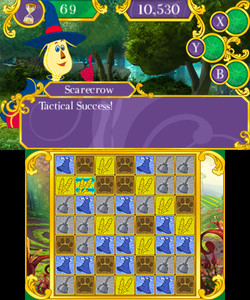
For a guy with no brain, the scarecrow knows a lot about tactics.
However, what may be a downer for younger players is that later stages are locked off until you complete the previous stage, with new worlds being being locked until you've achieved a high enough score on the earlier levels to amass a certain amount of gems. Gems are awarded as a kind of gold/silver/bronze reward for completing each stage, with a maximum of three on offer for those who smash through the top points boundary. Luckily, the main menu tells you exactly how many points you'll need to earn in each stage in order to earn each number of gems - but somewhat bizarrely, you can't actually check mid-level. Having some sort of meter showing you how close you are to earning another gem, or all three gems would have been useful, if nothing else, but it's an unusual omission here.
Gems aren't the only thing you'll unlock during the levels, though, as completing each stage will also earn you yellow bricks. By touching a small, and perhaps a bit easy to miss icon of a shopping basket, you can head to Glinda's Shop, where the good witch will sell you all manner of potions and goodies to help make your life that little bit easier, from a Twister, which shuffles the tiles on the board, to +Moves, which adds 5 extra moves to move limit levels when used. You can have a max of three items at any time, and each can only be used once - so sadly, there's no permanent way to up the number of turns/time you have in each stage.
In another interesting variation, each tile in the game corresponds to a certain character, so blue tiles are Dorothy's, grey oil cans are the Tin Man, yellow tiles with bundles of wheat on are the Scarecrow's, and so on. Every time you make a match, the relevant character will earn XP, and when they level up, making matches of four of more tiles will add a bonus, special power up tile to the grid. Make a match with that, and it'll unleash its awesome power upon your lowly grid, whether it's wiping out all the tiles on a row/column, destroying every tile of a certain colour, or simply causing a rainbow explosion for a few tiles either way around it.
So, there's a lot to take in here, and a lot of interesting things that go above and beyond what your average match three game offers. While locking off the stages, and the occasional difficulty spikes may present problems for some younger players, for the most part, this is a game that can be enjoyed by kids and grown ups alike. So long as you can tolerate the characters popping up on screen with words of encouragement every time you match four or more, anyway.
With a budget price, and plenty of stages to play through, not to mention the replay value that comes with trying to earn all the gems, this is well worth a look.
Format Reviewed: Nintendo 3DS


